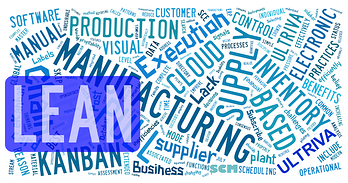Lean in its purest form is removal of waste. In today’s world, manufacturing is becoming more competitive than ever with shorter lead times, higher service levels, exploding number of finished goods SKUs, and thinning margins. Over the last twenty years, the focus of lean in manufacturing was concentrated on streamlining the factory floor, aligning of production lines, optimization of space, and standardizing of operating procedures.
 Through continuous process improvement lean has filtered into all areas of manufacturing operations including the back office with accounting functionality. Ironically the area with the greatest opportunity for short-term lean impacts has remained untouched: supply chain material replenishment.
Through continuous process improvement lean has filtered into all areas of manufacturing operations including the back office with accounting functionality. Ironically the area with the greatest opportunity for short-term lean impacts has remained untouched: supply chain material replenishment.
This omission is peculiar and egregious since purchase parts often amounts up to 60% of manufacturing costs. Kaizen events would quickly point lean initiative teams to apply lean methodologies to this critical process. Excess inventory devours margins. Part shortages reduce customer service levels and the result is lost revenues.
Looking toward 2014 this challenge will be exacerbated as Tier 1 suppliers demand cost containment from the Tier 2 and Tier 3 suppliers. Edicts are issued daily: Find 10% in price reduction or the manufacturer will no longer be included as an authorized vendor.
Until now the lean efforts have only been applied to areas where companies have full control, such as the shop floor. Lean is showing up as paramount in both supplier and customer collaboration.
Ultriva focuses on leaning the supply chain.
One of the fastest and most important factors to apply lean manufacturing principles to the material replenishment process is establishing a pull system. The underlying methodology for implementing a pull system is referred to as kanban, and historically kanban has always been used as a manual card-based system. Paper-based kanban was new and revolutionary 30 years ago; it worked well when manufacturing was vertically integrated and suppliers were located within a short radius.
The current global, 24/7 fast-paced environment where manufacturing is far less integrated and suppliers are located on every continent (except Antarctica) renders the manual kanban card system obsolete. Demonstrating agility and responsiveness to this new manufacturing alacrity was part of facing the changing realities of the supply chain. Ultriva pioneered the electronic kanban which turns the manual card system into a powerful closed-loop kanban through supplier collaboration and the real-time flow of order, shipment and receipt information. Ultriva maintains the visual nature of Kanban while guaranteeing “no lost cards” or “no duplicate cards”. The electronic Kanban is workflow-controlled to keep track of who did what, when and where. This allows several metrics to be automatically computed.
The result is facilitation of continuous improvement that is synchronized to the themes and purpose of lean manufacturing today.
If you would like to find out more about lean manufacturing, request our Lean Factory Demo



